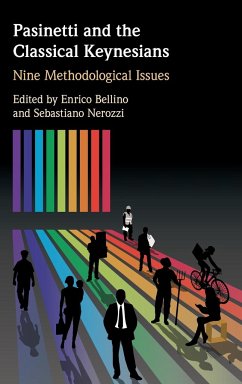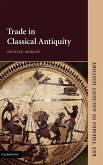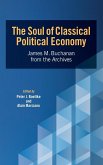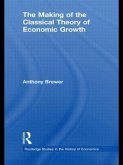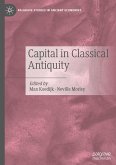Pasinetti and the Classical Keynesians
Herausgeber: Bellino, Enrico; Nerozzi, Sebastiano
Pasinetti and the Classical Keynesians
Herausgeber: Bellino, Enrico; Nerozzi, Sebastiano
- Gebundenes Buch
- Merkliste
- Auf die Merkliste
- Bewerten Bewerten
- Teilen
- Produkt teilen
- Produkterinnerung
- Produkterinnerung
Nine leading scholars discuss the nine main ideas that, according to Luigi Pasinetti, characterize the Classical-Keynesian approach.
Andere Kunden interessierten sich auch für
![Keynes and the Cambridge Keynesians Keynes and the Cambridge Keynesians]() Luigi L. PasinettiKeynes and the Cambridge Keynesians80,99 €
Luigi L. PasinettiKeynes and the Cambridge Keynesians80,99 €![Trade in Classical Antiquity Trade in Classical Antiquity]() Neville MorleyTrade in Classical Antiquity81,99 €
Neville MorleyTrade in Classical Antiquity81,99 €![The Soul of Classical Political Economy The Soul of Classical Political Economy]() The Soul of Classical Political Economy18,99 €
The Soul of Classical Political Economy18,99 €![The Soul of Classical Political Economy The Soul of Classical Political Economy]() James M. BuchananThe Soul of Classical Political Economy26,99 €
James M. BuchananThe Soul of Classical Political Economy26,99 €![The Making of the Classical Theory of Economic Growth The Making of the Classical Theory of Economic Growth]() Anthony BrewerThe Making of the Classical Theory of Economic Growth195,99 €
Anthony BrewerThe Making of the Classical Theory of Economic Growth195,99 €![The Young Lady's Book of Classical Letters: Consisting of Epistolary Selections: Designed to Improve Young Ladies and Gentlemen in the Art of Letter-W The Young Lady's Book of Classical Letters: Consisting of Epistolary Selections: Designed to Improve Young Ladies and Gentlemen in the Art of Letter-W]() AnonymousThe Young Lady's Book of Classical Letters: Consisting of Epistolary Selections: Designed to Improve Young Ladies and Gentlemen in the Art of Letter-W35,99 €
AnonymousThe Young Lady's Book of Classical Letters: Consisting of Epistolary Selections: Designed to Improve Young Ladies and Gentlemen in the Art of Letter-W35,99 €![Capital in Classical Antiquity Capital in Classical Antiquity]() Capital in Classical Antiquity119,99 €
Capital in Classical Antiquity119,99 €-
-
-
Nine leading scholars discuss the nine main ideas that, according to Luigi Pasinetti, characterize the Classical-Keynesian approach.
Hinweis: Dieser Artikel kann nur an eine deutsche Lieferadresse ausgeliefert werden.
Hinweis: Dieser Artikel kann nur an eine deutsche Lieferadresse ausgeliefert werden.
Produktdetails
- Produktdetails
- Verlag: Cambridge University Press
- Seitenzahl: 346
- Erscheinungstermin: 19. Januar 2022
- Englisch
- Abmessung: 235mm x 157mm x 23mm
- Gewicht: 652g
- ISBN-13: 9781108831116
- ISBN-10: 1108831117
- Artikelnr.: 62847166
- Herstellerkennzeichnung
- Libri GmbH
- Europaallee 1
- 36244 Bad Hersfeld
- gpsr@libri.de
- Verlag: Cambridge University Press
- Seitenzahl: 346
- Erscheinungstermin: 19. Januar 2022
- Englisch
- Abmessung: 235mm x 157mm x 23mm
- Gewicht: 652g
- ISBN-13: 9781108831116
- ISBN-10: 1108831117
- Artikelnr.: 62847166
- Herstellerkennzeichnung
- Libri GmbH
- Europaallee 1
- 36244 Bad Hersfeld
- gpsr@libri.de
Foreword Mauro Baranzini, Alberto Quadrio Curzio and Roberto Scazzieri;
Introduction Enrico Bellino, Sebastiano Nerozzi; 1. Reality (and not simply
Abstract Rationality) as the Starting Point of Economic Theory Maria
Cristina Marcuzzo; 2. Economic Logic with Internal Consistency (and not
only Formal Rigor): Beyond Formal Rigour: Realism and Internal Consistency
in Piero Sraffa Neri Salvadori, Rodolfo Signorino; 3. Malthus and the
Classics (not Walras and the Marginalists) as the Major Inspiring Source in
the History of Economic Thought: The Principle of Effective Demand and
Classical Economics Heinz D. Kurz; 4. Non-ergodic (in Place of Stationary,
Timeless) Economic Systems: Considerations Suggested by Joan Robinson's
Distinction between Two 'Notions' of Time in Economic Theory Ariel Dvoskin,
Paolo Trabucchi; 5. Causality vs. Interdependence: A Distinction that
Conveys a World's View Enrico Bellino, Sebastiano Nerozzi; 6.
Macroeconomics before Microeconomics: A Sceptic's Guide to Macroeconomics
Murray Milgate, John Eatwell; 7. Disequilibrium: Disequilibrium and
Instability (Not Equilibrium) as the Normal State of the Industrial
Economies: A Methodological Standpoint on Structural Economic Dynamics
Ariel Luis Wirkierman; 8. Necessity of Finding an Appropriate Analytical
Framework for Dealing with Technical Change and Economic Growth: Technical
Change, Structural Dynamics and Employment Harald Hagemann; 9. A Strong,
Deeply Felt, Social Concern Claudia Rotondi; Afterword: Why the
Classic-Keynesian Trend May Be of Interest to a Young Scholar Today? Nadia
Garbellini; Concluding Remarks: Pasinetti's Separation Theorem Bertram
Schefold; Author Index; Subject Index.
Introduction Enrico Bellino, Sebastiano Nerozzi; 1. Reality (and not simply
Abstract Rationality) as the Starting Point of Economic Theory Maria
Cristina Marcuzzo; 2. Economic Logic with Internal Consistency (and not
only Formal Rigor): Beyond Formal Rigour: Realism and Internal Consistency
in Piero Sraffa Neri Salvadori, Rodolfo Signorino; 3. Malthus and the
Classics (not Walras and the Marginalists) as the Major Inspiring Source in
the History of Economic Thought: The Principle of Effective Demand and
Classical Economics Heinz D. Kurz; 4. Non-ergodic (in Place of Stationary,
Timeless) Economic Systems: Considerations Suggested by Joan Robinson's
Distinction between Two 'Notions' of Time in Economic Theory Ariel Dvoskin,
Paolo Trabucchi; 5. Causality vs. Interdependence: A Distinction that
Conveys a World's View Enrico Bellino, Sebastiano Nerozzi; 6.
Macroeconomics before Microeconomics: A Sceptic's Guide to Macroeconomics
Murray Milgate, John Eatwell; 7. Disequilibrium: Disequilibrium and
Instability (Not Equilibrium) as the Normal State of the Industrial
Economies: A Methodological Standpoint on Structural Economic Dynamics
Ariel Luis Wirkierman; 8. Necessity of Finding an Appropriate Analytical
Framework for Dealing with Technical Change and Economic Growth: Technical
Change, Structural Dynamics and Employment Harald Hagemann; 9. A Strong,
Deeply Felt, Social Concern Claudia Rotondi; Afterword: Why the
Classic-Keynesian Trend May Be of Interest to a Young Scholar Today? Nadia
Garbellini; Concluding Remarks: Pasinetti's Separation Theorem Bertram
Schefold; Author Index; Subject Index.
Foreword Mauro Baranzini, Alberto Quadrio Curzio and Roberto Scazzieri;
Introduction Enrico Bellino, Sebastiano Nerozzi; 1. Reality (and not simply
Abstract Rationality) as the Starting Point of Economic Theory Maria
Cristina Marcuzzo; 2. Economic Logic with Internal Consistency (and not
only Formal Rigor): Beyond Formal Rigour: Realism and Internal Consistency
in Piero Sraffa Neri Salvadori, Rodolfo Signorino; 3. Malthus and the
Classics (not Walras and the Marginalists) as the Major Inspiring Source in
the History of Economic Thought: The Principle of Effective Demand and
Classical Economics Heinz D. Kurz; 4. Non-ergodic (in Place of Stationary,
Timeless) Economic Systems: Considerations Suggested by Joan Robinson's
Distinction between Two 'Notions' of Time in Economic Theory Ariel Dvoskin,
Paolo Trabucchi; 5. Causality vs. Interdependence: A Distinction that
Conveys a World's View Enrico Bellino, Sebastiano Nerozzi; 6.
Macroeconomics before Microeconomics: A Sceptic's Guide to Macroeconomics
Murray Milgate, John Eatwell; 7. Disequilibrium: Disequilibrium and
Instability (Not Equilibrium) as the Normal State of the Industrial
Economies: A Methodological Standpoint on Structural Economic Dynamics
Ariel Luis Wirkierman; 8. Necessity of Finding an Appropriate Analytical
Framework for Dealing with Technical Change and Economic Growth: Technical
Change, Structural Dynamics and Employment Harald Hagemann; 9. A Strong,
Deeply Felt, Social Concern Claudia Rotondi; Afterword: Why the
Classic-Keynesian Trend May Be of Interest to a Young Scholar Today? Nadia
Garbellini; Concluding Remarks: Pasinetti's Separation Theorem Bertram
Schefold; Author Index; Subject Index.
Introduction Enrico Bellino, Sebastiano Nerozzi; 1. Reality (and not simply
Abstract Rationality) as the Starting Point of Economic Theory Maria
Cristina Marcuzzo; 2. Economic Logic with Internal Consistency (and not
only Formal Rigor): Beyond Formal Rigour: Realism and Internal Consistency
in Piero Sraffa Neri Salvadori, Rodolfo Signorino; 3. Malthus and the
Classics (not Walras and the Marginalists) as the Major Inspiring Source in
the History of Economic Thought: The Principle of Effective Demand and
Classical Economics Heinz D. Kurz; 4. Non-ergodic (in Place of Stationary,
Timeless) Economic Systems: Considerations Suggested by Joan Robinson's
Distinction between Two 'Notions' of Time in Economic Theory Ariel Dvoskin,
Paolo Trabucchi; 5. Causality vs. Interdependence: A Distinction that
Conveys a World's View Enrico Bellino, Sebastiano Nerozzi; 6.
Macroeconomics before Microeconomics: A Sceptic's Guide to Macroeconomics
Murray Milgate, John Eatwell; 7. Disequilibrium: Disequilibrium and
Instability (Not Equilibrium) as the Normal State of the Industrial
Economies: A Methodological Standpoint on Structural Economic Dynamics
Ariel Luis Wirkierman; 8. Necessity of Finding an Appropriate Analytical
Framework for Dealing with Technical Change and Economic Growth: Technical
Change, Structural Dynamics and Employment Harald Hagemann; 9. A Strong,
Deeply Felt, Social Concern Claudia Rotondi; Afterword: Why the
Classic-Keynesian Trend May Be of Interest to a Young Scholar Today? Nadia
Garbellini; Concluding Remarks: Pasinetti's Separation Theorem Bertram
Schefold; Author Index; Subject Index.

